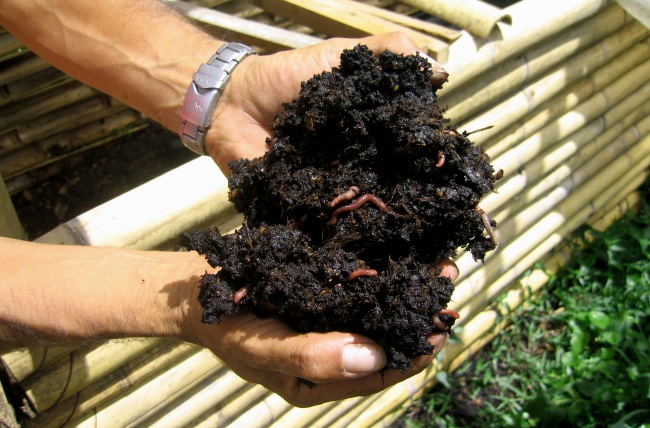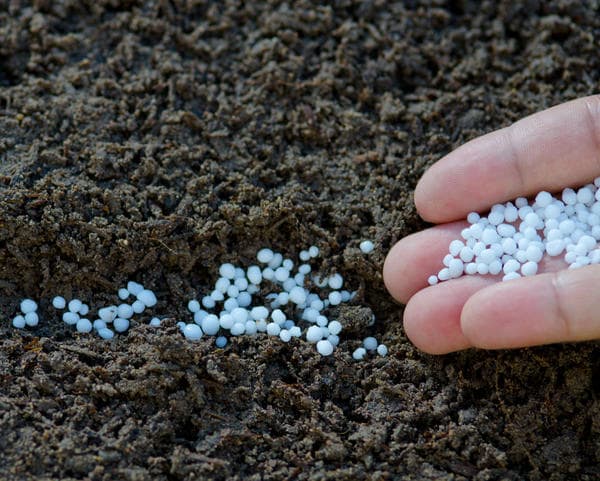Garden fertilizers and garden
To improve the composition and structure of the soil, to increase the fertility of the soil and obtaining good yields it is necessary to make fertilizers. Ferms are divided into organic fertilizers and mineral fertilizers. When to make fertilizers? What fertilizers are made in the fall in the soil, and what fertilizers in the spring are introduced when planting plants? First of all, consider organic fertilizers.
1 humid or compost - valuable organic fertilizer. Contains potassium, magnesium, phosphorus. It is pretty easy to prepare from the remains of plants that focused foliage, small branches and other organic matter. Folding gradually all the waste of the garden and the garden in a certain place (compost pit) in a year we obtain valuable fertilizers for plants.
2 Manure or chicken litter - efficient organic fertilizer. But it is necessary to apply it in small dosages and well overworked. Manure contains nitrogen, but in long decomposing compounds, therefore it is necessary to join the manure.
3 Lake or River Il. Valuable organic fertilizer. The lake il - sapropel is most appreciated. But it is possible to use it as a fertilizer only after conducting, which removes excessive moisture and harmful connections. The best fertilizer fertilizer is a compost with the addition of il.
4 Herbal infusions. This organic fertilizer is applied as root and extraxnealing feeders. Herbal infusions are made from a certain type of grass (crop, chamomile, socket), also just from the green mass of prefabricated herbs.
5 Bioguumus - fertilizer, obtained in the process of processing plant residues of the organic with the help of Californian worms.

6 - plants that are grown for subsequent steps and close up in the soil for obtaining fertilizer, improving the structure of the soil and the fight against weeds.
All these fertilizers improve the composition of the soil, improve soil fertility, have a positive effect on the development of plants. But the disadvantage of organic fertilizers is that they are made to the soil are required in large quantities compared with mineral fertilizers.
Plant fertilizers Video:
Mineral fertilizers are: nitrogen potassium and phosphate. Briefly stop at each of them.
Nitrogen - An important component for the development of plants. Nitrogen need is large in the first half of the vegetation. Lack of nitrogen - yellow leaves, lag in growth and development. Excess nitrogen leads to excessive growth of green mass sometimes to the detriment of harvest and excessive accumulation of nitrates in the fruits. What are nitrogen fertilizers?
Carbomide or urea - fertilizer, which contains 46% nitrogen. It is used for root and extractive feeding.
Ammonium nitrate - nitrogen content 35% You can feed plants when watering, as the nitrate is well dissolved in water. Imagine an ammonium saltper is better in spring.
Ammonium sulfate is a nitrogen content of 20%. This drug is also well soluble in water.
Sodium Selith - Nitrogen content 16%. It is used for filtering plants when watering.
Calfberry Selitra - Nitrogen content of about 17%. Replaces for root and extractive feeding. Very good for feeding onion of bulbous plants.
Nitrogen is also contained in complex mineral fertilizers, such as almophos, azophoska.

Phosphorusa plant is needed at all stages of vegetation. Phosphorus is needed with the development of the root system of the plant, when it is blooming, in the formation of fruits. For perennial plants phosphorus is very important, because it affects the winter hardiness of the plant. With a lack of phosphorus, the plant is poorly developed, has a weak root system, weak shoots. The main source of phosphate compounds is manure, compost, humus. Plant phosphor is assimilated only in water soluble compounds. Although phosphorus compounds may not be soluble in water, but soluble in weak acids, and therefore in acidic soils. As well as phosphorus, not soluble in water and weak acids, but gradually, under the action of acids in the soil, root discharge of plants, these phosphorus compounds are converted into the compounds digestible. The overabundance of phosphorus blocks the assimilation by the microelerant plant such as iron, magnesium, calcium.
In organic fertilizers, phosphorus is contained in ash to 7%.
superphosphate - fertilizer containing about 20% phosphorus oxide.
Superfos - fertilizer containing about 40% phosphorus oxide.
Precipate - contains about 30% phosphorus oxide.
Bone flour - contains about 30% phosphorus oxide.
Potassium It affects the set of processes occurring in plants from seed germination to resistance to temperature differences and disease resistance. The potassium content in the soil depends directly from the structure and composition of the soil. Greater potassium content in clay soils. Make potash fertilizers better. A sufficiently large number of potassium is contained in wood ashes, but it is not necessary to connect ash with other fertilizers and manure, it worsens the quality of fertilizers. What fertilizers contain potassium?
Potassium sulfate is potassium content up to 52%. Fertilizer is brought in autumn.
Potash Selith is potassium content up to 45%. Fertilizer contribute in spring.
Kalimagnesia - potassium content up to 25% and 18% magnesium. Brought as root and extracurricular fantasics of plants. Used as fertilizers for potatoes, for tomatoes.